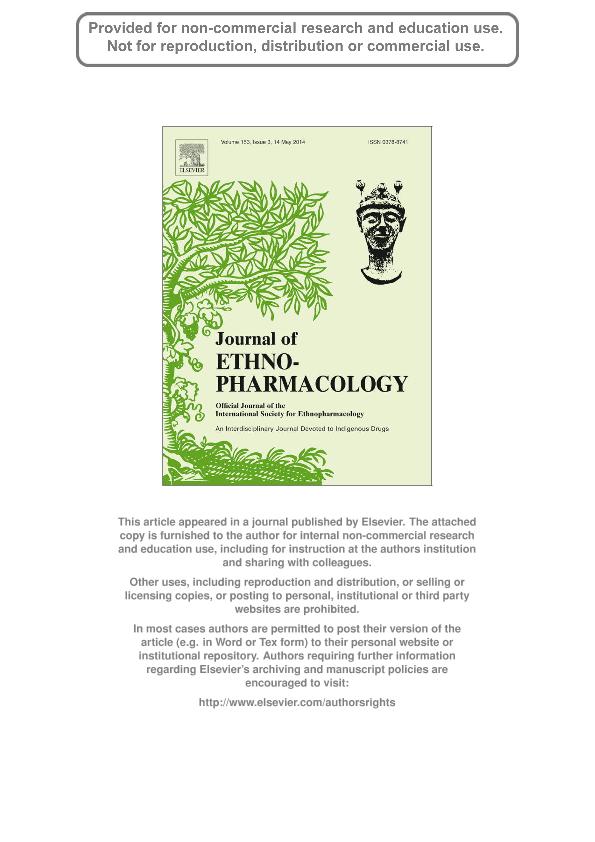Mostrar el registro sencillo del ítem
dc.contributor.author
Kujawska, Monika
dc.contributor.author
Hilgert, Norma Ines

dc.date.available
2018-02-15T19:19:19Z
dc.date.issued
2014-05
dc.identifier.citation
Kujawska, Monika; Hilgert, Norma Ines; Phytotherapy of polish migrants in Misiones, Argentina: Legacy and acquired plant species; Elsevier Ireland; Journal of Ethnopharmacology; 153; 3; 5-2014; 810-830
dc.identifier.issn
0378-8741
dc.identifier.uri
http://hdl.handle.net/11336/36565
dc.description.abstract
Ethnopharmacological relevance Analyzing how and why phytotherapeutical practices survive a migratory process is important for understanding migrant health seeking behaviour and health demand. Contrary to most studies, which focus on migrants from warm climates who settle in European and American cities, this study explores continuations in the herbal pharmacopoeia of Eastern European peasants who settled down in rural subtropical areas of Argentina. The study also explores the pharmacopoeia among the descendants of the first generation born in Argentina. Material and methods Primary and secondary sources were employed in the study. Data were collected during over 200 interviews (semi-structured, free lists and in-depth) with 94 study participants. Voucher specimens of species mentioned were gathered and identified. Illnesses were reported according to local ethnomedical terminology and classification. Only reports from informants' own experience were included in the analysis. The unit of analysis was a plant use report (plant species×plant part×ailment×informant). The frequency of mentions was calculated for plant parts used and modes of preparation and administration of herbal medicines, and the Informant Diversity Value was also estimated. Secondary information was obtained from ethnobotanical and ethnomedical literature concerning the whole of Poland. A list was made of medicinal plant species known from Poland available in the study area. Then, the similarity between the available species and those used by Polish migrants was evaluated by applying the Simpson index. Results An exhaustive list of 129 plant species used by the Polish community in Misiones, Argentina, was obtained. Among 37 species known form Poland and available in Misiones, 19 were used by the community. There was low consensus on the treatment of health conditions with legacy plants between Polish migrants and the Polish folk pharmacopoeia. The reasons for the relatively low use of legacy species are explained. More continuation has been observed in forms of application and administration of medicinal plants. Most of the continued species are food plants and are predominantly applied as medicinal food. Conclusions In the migratory process, Polish peasants have preserved culturally salient species, which have a wide range of therapeutic applications and are easily accessible. Polish migrants and their descendants have incorporated a great number of local medicinal plant species into their home medicine but at the same time retained traditional ways of administration of herbal medicines. Based on the theory of acculturation, the observed patterns of medicinal plant use in Polish migrant colonies in Misiones indicate good adaptation to the predominant cultural environment. © 2014 Elsevier Ireland Ltd.
dc.format
application/pdf
dc.language.iso
eng
dc.publisher
Elsevier Ireland

dc.rights
info:eu-repo/semantics/openAccess
dc.rights.uri
https://creativecommons.org/licenses/by-nc-sa/2.5/ar/
dc.subject
Heritage Plant Species
dc.subject
Medicinal Plants
dc.subject
Informant Diversity Value
dc.subject
Pharmacopeia Validation
dc.subject
Optimal Adaptation
dc.subject
Ways of Preparation And Administrarion
dc.title
Phytotherapy of polish migrants in Misiones, Argentina: Legacy and acquired plant species
dc.type
info:eu-repo/semantics/article
dc.type
info:ar-repo/semantics/artículo
dc.type
info:eu-repo/semantics/publishedVersion
dc.date.updated
2016-12-26T18:46:18Z
dc.journal.volume
153
dc.journal.number
3
dc.journal.pagination
810-830
dc.journal.pais
Irlanda

dc.journal.ciudad
Amsterdam
dc.description.fil
Fil: Kujawska, Monika. Consejo Nacional de Investigaciones Científicas y Técnicas. Centro Científico Tecnológico Conicet - Nordeste. Instituto de Biología Subtropical. Universidad Nacional de Misiones. Instituto de Biología Subtropical; Argentina. Uniwersytet Im. Adama Mickiewicza W Poznaniu; Polonia
dc.description.fil
Fil: Hilgert, Norma Ines. Consejo Nacional de Investigaciones Científicas y Técnicas. Centro Científico Tecnológico Conicet - Nordeste. Instituto de Biología Subtropical. Universidad Nacional de Misiones. Instituto de Biología Subtropical; Argentina
dc.journal.title
Journal of Ethnopharmacology

dc.relation.alternativeid
info:eu-repo/semantics/altIdentifier/url/http://www.sciencedirect.com/science/article/pii/S0378874114002347
dc.relation.alternativeid
info:eu-repo/semantics/altIdentifier/doi/https://doi.org/10.1016/j.jep.2014.03.044
Archivos asociados
